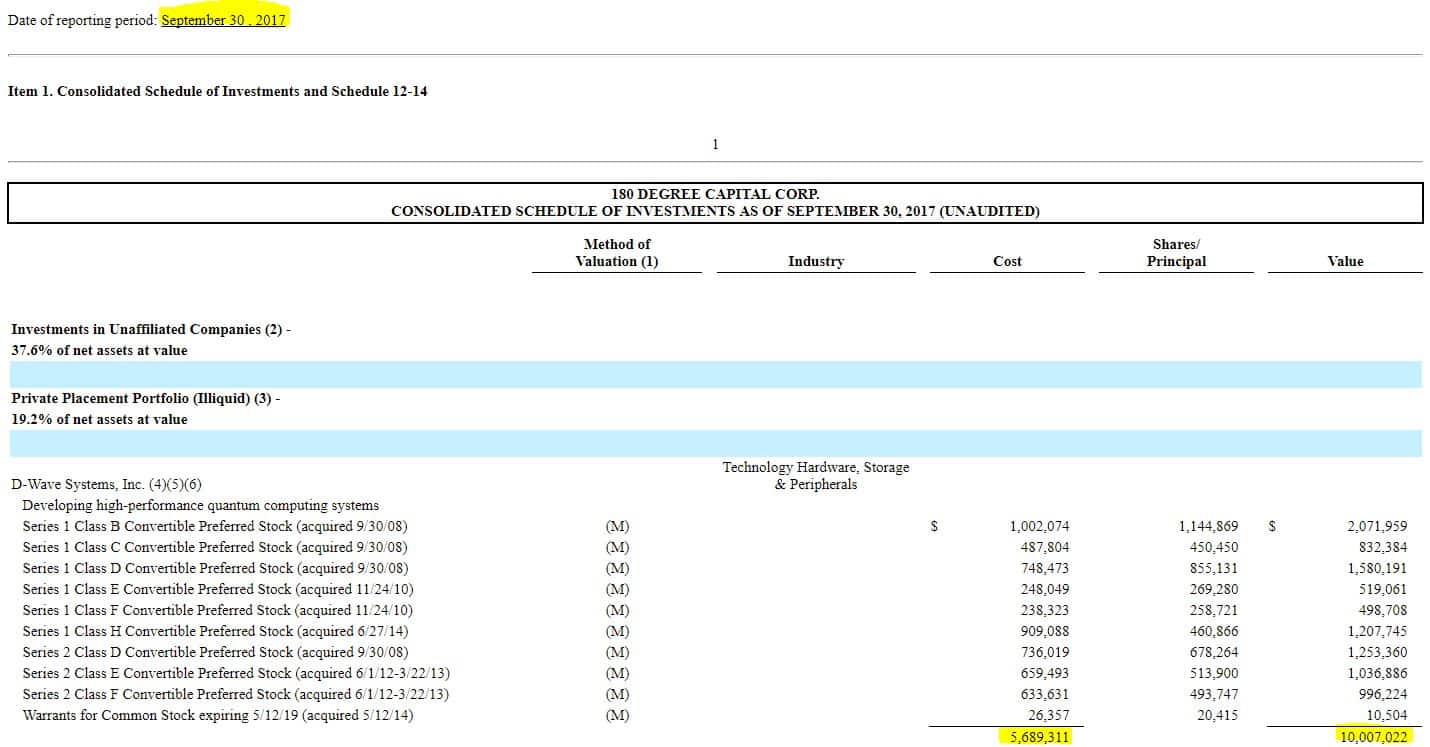Investing in Quantum Computing with D-Wave
Table of contents
Table of contents

If your job is to provide insights on how to invest in disruptive technologies like we do here at Nanalyze, then it’s inevitable that you’ll be asked about what investments to make in any number of situations. These types of questions open up ginormous cans of worms. For example, a common question we get is “would you buy stock X, Y, or Z”. If we were to start telling people what to “buy”, then we’d need to ask them some questions like:
- What percentage of your assets are you playing with?
- What’s your appetite for risk?
- Do you have a broker like Interactive Brokers that lets you do “dollar cost averaging” economically?
- Do you know what dollar cost averaging is?
- What’s your time horizon?
- Have you read up-to-date information SEC filings for stock so you have a glimpse into their current state of affairs?
- What will you do if the stock price drops by 50%? Double down or panic and sell?
And the list goes on. Then once you’ve dispensed your wisdom to the masses about what they should do, expect them to regularly lob questions at you in response to volatile share price movements (which are all but expected for tech stocks). It’s just not worth it for either party. People should always make investments based on their own convictions. Still, the questions are constantly being asked, so we presently have our MBAs working on a “Nanalyze Guide to Investing in Disruptive Technologies” which will also make mention of what we’re holding and some of our thoughts on our positions. The guide will be priced at about the same price as a night out in Podunk USA, so we expect to sell a bunch of them and use the money to feed our MBAs and to buy cannabis with. So what does this have to do with D-Wave and why are we shamelessly plugging something we want to sell you instead of offering up more free insights? Let’s get to that now.
One of our extremely good looking and remarkably intelligent readers asked us a question about investing in D-Wave. Long story short, we wrote an article back in May of 2016 on 3 Ways to Invest in D-Wave and two of the ways involved buying stocks; 180 Degree Capital Corp (NASDAQ:TURN) and Pender Growth Fund (CVE:PTF). The question was simply whether or not we would consider buying either of these stocks today. This is the sort of vague question that needs a 1,200-word article to answer it, so let’s get started on that.
Update 08/07/2018 – Note that just searching for the ticker PTF on Yahoo Finance will return an Invesco ETF. That is not the PTF we are discussing here. If you search for “Pender Growth Fund” on Yahoo Finance for example, then you will see PNDFF and PTF.V. The first appears to be a pink sheet proxy for the Canadian shares. The second appears to be the one we’re talking about (listed as PTF.V), at least that’s what Yahoo Finance says. You all use different brokers and we have no idea how they may handle this, plus, only a small percentage of our readers know what a CUSIP is (thank God). If you’re still having trouble, maybe this link will help:
https://www.bloomberg.com/quote/PTF:CN
About D-Wave
D-Wave is a popular topic because they are a player in the race to bring quantum computing mainstream. They are hardly the only player in this space. We’ve previously written about The Definition of Quantum Everything and talked about at least 10 Quantum Computing Companies working towards making quantum computing commercially viable. As you can see, D-Wave has some competitors, but none as formidable as the 4 big tech companies we talked about in our article on Artificial Intelligence (AI) and Quantum Computing. In that article, we talk about how companies like Google and IBM seem to be on the cusp of unveiling something big. D-Wave should probably be most concerned about these large companies whose deep pockets and large networks have a better chance at making things happen. So what has D-Wave been up to lately?
Even though D-Wave is going up against companies with billions of dollars to throw at quantum computing, this Canadian startup has still managed to raise an impressive $174 million in funding since they were founded back in 1999. Their last round was in May of 2017, and the list of investors backing the company contains some heavy hitters like Goldman Sachs, Fidelity, DFJ, In-Q-Tel, and even Jeff Bezos.
Update 12/12/2019: D-Wave has raised $10 million in funding from the Japanese industrial giant NEC to develop hybrid services that combine NEC’s supercomputers and other classical systems with D-Wave’s quantum technology. This brings the company’s total funding to $204.7 million to date.
One of their investors is also 180 Degree Capital Corp (NASDAQ:TURN) which used to be known as Harris and Harris Group or TINY. 180 Degree Capital is a publicly traded technology investing company with somewhat of a turbulent past. The last time we looked at TURN as a vehicle to invest in D-Wave was about 20 months ago when we wrote about 3 Ways to Invest in D-Wave Stock Right Now Pre-IPO. Let’s take a look at the entire D-Wave holding for TURN today:

In this case, we want to know how many shares of D-Wave TURN holds and what they value them at. We can see that this information is dated September of 2017, and that’s the latest we could find today. We also see that they have ~5.7 million shares valued at ~10 million dollars. However TURN is not just holding a position in D-Wave, but rather an entire portfolio of investments, the value of which we refer to as their “Net Asset Value” or NAV. The last time we checked, D-Wave constituted around 16% of TURN’s NAV. Given the most recent NAV of around $83.5 million, that percentage has now changed to around 12%. What’s also interesting to note is the following statement from TURN:
We changed the valuation methodology of our securities of D-Wave Systems, Inc., from the hybrid approach to the market approach owing to terms of a secondary market transaction of securities of the company that became the primary input to determining value.
That means that there are shares of D-Wave being traded on the secondary market, so you’re probably better off going out there and finding out where. This might be a good topic for a future article, but today we’re just talking about TURN and PTF. Now that we know shares of TURN give you about a 12% exposure to shares of D-Wave, let’s move on to looking at the Pender Growth Fund or PTF:

We can see that PTF holds 1.1 million shares of D-Wave as of June 2017. If we use the same valuation as TURN does of $1.76 a share, then that would mean that the D-Wave shares held by PTF are worth about $1.97 million. Since PTF has a NAV of $19.2 million, this means that you’re getting about 10% exposure to D-Wave shares by investing in Pender Growth Fund.
Conclusion
So let’s rehash the original question. Would we buy shares of TURN or PTF today to get exposure to shares of D-Wave? The answer is no because we would much rather find shares of D-Wave to buy on the secondary market that would give us 100% exposure. Investing in either of these two holding companies would require additional due diligence to know more about “the other 90%” of our holding. Of course, either company may stand up well on its own merits, but that is a topic for another conversation altogether.
The other thing you need to consider is that not all quantum computers are the same. D-Wave says they offer a 2,000 qubit machine yet IBM’s big breakthrough announced late last year was just a 50 qubit machine. A bigger number is better in this case, so why is there such a large discrepancy here? That’s because not all computing is the same, a topic we covered in our article on Quantum Computers vs. Supercomputers vs. Mainframes. If you recall, there is actually a lot of controversy behind D-Wave’s machines so you need to take that into consideration as well before thinking about investing in quantum computing with D-Wave, no matter what method you decide to use.
Sign up to our newsletter to get more of our great research delivered straight to your inbox!
Nanalyze Weekly includes useful insights written by our team of underpaid MBAs, research on new disruptive technology stocks flying under the radar, and summaries of our recent research. Always 100% free.















So how can one invest in D-Wave on the “Secondary Market”?
Apologies Todd, our community manager has been slacking. You’d have to watch each secondary market out there to see if they list D-Wave shares.
D-Wave is not a true quantum computing. I am going to ignore it.
I’m sure they’d probably have an opinion on that but to each his own.
Well, you can invest in D-Wave now! It’s going public via SPAC XPOA.
Shore enough pardner. We’ll be covering that one soon. Stay tuned.